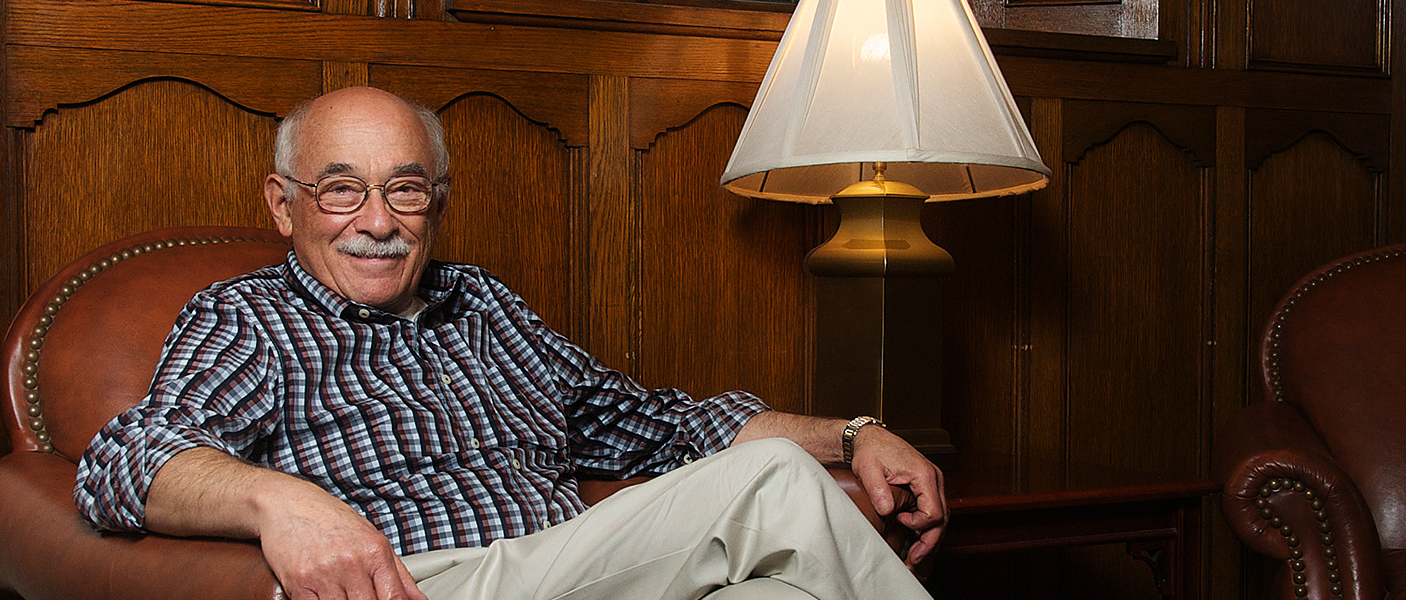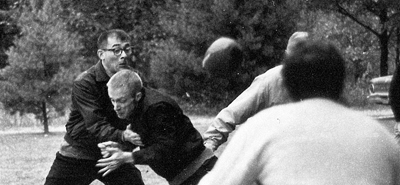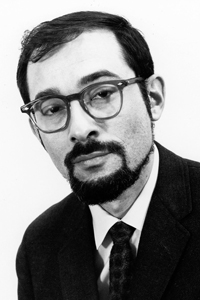

By Henry Appelman | 12 February
A set of buzzwords, actually a buzzphrase, currently in widespread use throughout the University of Michigan, including its Department of Pathology, is “the Michigan Difference”, implying excellence here, compared to the other places and services on the planet, all of which apparently accept mediocrity or worse as a performance standard. As someone who has been part of the faculty of the Department of Pathology for 45 years, I may more appropriately be designated as an example of “the Michigan sameness”, rather than “the Michigan difference”. This sameness, basically an inability to find a job in another place, has given me a long term opportunity to see from within what has happened to this department over the long haul, and, hopefully, it has also given me the opportunity to look at the department’s evolution over almost half a century.

Appelman playing football on Campus
I went to the University of Michigan for my undergraduate and medical school educations. I actually started working in the Department of Pathology as a second year medical student, and I stayed on as a Pathology Resident because I felt comfortable here, and because I did not have enough money to go elsewhere. After I finished my residency, I spent a few years in other places and, as luck would have it, I was called back to my medical roots –the Department of Pathology at Michigan. I began as an Assistant Professor in 1969 and gradually climbed the academic ladder to full Professor-hood about seven years later. I lived in four faculty offices from 1969 to the present – two on the fourth floor, one on the fifth floor in the Pathology building, and one in the University Hospital which opened in 1986. This meant that I have had to pack up all my junk and move only four times. This brief professional autobiography sets the stage for my views of what has happened in the past 45 years.
During my tenure here, I have seen and been a part of several huge changes in department goals, essentially seismic shifts, which I believe are much more powerful than simple paradigm shifts that almost anyone can undertake. As a medical student working in the department, I had no concept of trends in pathology, and as a Resident I was indifferent to trends since I felt that I would complete my training and leave. As a faculty member, I had a solid stake in what was happening in the department.

Dr. Henry Appelman, 1962
The first decade – the A. James French years – were highlighted by an emphasis on continued consolidation of the clinical laboratories, spread around the medical center and run by faculty in several different departments, into a single Pathology department. As it turned out, this was happening in a number of departments all over the country, often under the direction of world renowned pathology chairmen who were well known friends and colleagues of Dr. French. This was also the period when the small faculty was expanded to include young pathologists with specialty diagnostic expertise. Each clinical laboratory and anatomic pathology service had leaders who were usually the only faculty members with interest in those specific services. Dr. French actively encouraged the faculty to engage in clinical research and publish the results. In contrast, basic science research, which was being promoted intensely in pathology departments in other prestigious institutions, was mainly limited to a small laboratory run by Barry Pierce, who subsequently became the Chair of Pathology at the University of Colorado. As it turned out, although the department offered exceptional diagnostic services in anatomic and clinical pathology with many of its faculty developing national reputations in the diagnostic fields, the lack of a high powered basic science research program became the defining issue when Dr. French retired and recruitment of a new Chair was undertaken.
“During my tenure here, I have seen and been a part of several huge changes in department goals, essentially seismic shifts, which I believe are much more powerful than simple paradigm shifts that almost anyone can undertake.”
The first seismic shift began with the appointment of Dr. Peter Ward as the Chair to replace Dr. French in 1980. Peter Ward, who trained in anatomic pathology under Dr. French, was known for his remarkable basic research accomplishments and breakthroughs in inflammation. He brought with him a group of young, energetic,and creative scientists from the University of Connecticut where he had been Chairman before coming back to Michigan. Thus began the emphasis on basic research that has continued to the present. Dr. Ward formalized the positions of Director of Anatomic Pathology and Director of Clinical Pathology, and he appointed an individual to direct the Residency Training Program. During this period, the departmental ambience was one of research excellence, grant getting, and reputation developing. It was expected that the clinical services would continue to produce outstanding work, and while they did so, some superb investigators from around the country were recruited as faculty by Dr. Ward, many of whom became internationally known scientists, and many of whom are currently active. Nevertheless, in spite of the basic research emphasis, during this period several outstanding clinically-oriented faculty were hired, many of whom are still active and productive today, and many of whom are also nationally and internationally known for their clinical expertise.
In 2005, Dr. Peter Ward was replaced by Dr. Jay Hess, a clinically
trained hematopathologist and outstanding investigator with an active, highly funded research laboratory dealing with the genetics of leukemias. Under his leadership, the emphasis on basic science research continued, but there was renewed emphasis on development and expansion of the diagnostic services. During Dr. Hess’ recruitment, the powers-that-be in the medical center recognized that there was a long-standing extreme need for additional departmental space, mainly for improved clinical services. Several plans for such extra space, including new buildings, were proposed during Dr. Hess’ tenure, and a couple of them even had beginning architectural analyses, but none of these proposals survived beyond the initial planning stages. During the “Hess Years” many young, energetic, and diagnostically superb new faculty were hired, most of whom are still members of the faculty today.
In addition, Dr. Hess expanded his own research program, incorporating scientists who were not trained in the medicine and science of pathology, but who were accomplished scientists in other areas, such as pharmacology.
In 2013, Dr. Hess accepted the position as Dean of the School of Medicine and Vice President for University Clinical Affairs at Indiana University, so another Chair search was initiated. During the period extending from the exodus of Dr. Hess to the installation of our new Chair, Dr. Charles Parkos, Dr. Kathleen Cho served as Interim Chair. Dr. Cho dove into the morass of Chair-personhood with both feet flying, and she held the department together in grand and glorious fashion, including every research laboratory and every clinical service. She also started new initiatives, including detailed planning for additional space for the clinical services. She has been the role model for an Interim Chair, and in fact, is THE role model for a permanent Chair. Now we have the “Parkos Years” in front of us. They have barely begun, and by the time they have covered the first few months, this 45 year veteran of the departmental shifts will have probably lost all perspective, and someone else will have to take on the next such historical evaluation.
---
This article first appeared in Inside Pathology, 2014. If you knew Henry Appelman back in the day, you’ll still know him now. Dr. Appelman is still a Professor in the Department of Pathology and Director of the Gastrointestinal Pathology Fellowship Program.
 ON THE COVER
ON THE COVER
Breast team reviewing a patient's slide. (From left to right) Ghassan Allo, Fellow; Laura Walters, Clinical Lecturer; Celina Kleer, Professor. See Article 2014Department Chair |

newsletter
INSIDE PATHOLOGYAbout Our NewsletterInside Pathology is an newsletter published by the Chairman's Office to bring news and updates from inside the department's research and to become familiar with those leading it. It is our hope that those who read it will enjoy hearing about those new and familiar, and perhaps help in furthering our research. CONTENTS
|
 ON THE COVER
ON THE COVER
Autopsy Technician draws blood while working in the Wayne County morgue. See Article 2016Department Chair |

newsletter
INSIDE PATHOLOGYAbout Our NewsletterInside Pathology is an newsletter published by the Chairman's Office to bring news and updates from inside the department's research and to become familiar with those leading it. It is our hope that those who read it will enjoy hearing about those new and familiar, and perhaps help in furthering our research. CONTENTS
|
 ON THE COVER
ON THE COVER
Dr. Sriram Venneti, MD, PhD and Postdoctoral Fellow, Chan Chung, PhD investigate pediatric brain cancer. See Article 2017Department Chair |

newsletter
INSIDE PATHOLOGYAbout Our NewsletterInside Pathology is an newsletter published by the Chairman's Office to bring news and updates from inside the department's research and to become familiar with those leading it. It is our hope that those who read it will enjoy hearing about those new and familiar, and perhaps help in furthering our research. CONTENTS
|
 ON THE COVER
ON THE COVER
Director of the Neuropathology Fellowship, Dr. Sandra Camelo-Piragua serves on the Patient and Family Advisory Council. 2018Department Chair |

newsletter
INSIDE PATHOLOGYAbout Our NewsletterInside Pathology is an newsletter published by the Chairman's Office to bring news and updates from inside the department's research and to become familiar with those leading it. It is our hope that those who read it will enjoy hearing about those new and familiar, and perhaps help in furthering our research. CONTENTS
|
 ON THE COVER
ON THE COVER
Residents Ashley Bradt (left) and William Perry work at a multi-headed scope in our new facility. 2019Department Chair |

newsletter
INSIDE PATHOLOGYAbout Our NewsletterInside Pathology is an newsletter published by the Chairman's Office to bring news and updates from inside the department's research and to become familiar with those leading it. It is our hope that those who read it will enjoy hearing about those new and familiar, and perhaps help in furthering our research. CONTENTS
|
 ON THE COVER
ON THE COVER
Dr. Kristine Konopka (right) instructing residents while using a multi-headed microscope. 2020Department Chair |

newsletter
INSIDE PATHOLOGYAbout Our NewsletterInside Pathology is an newsletter published by the Chairman's Office to bring news and updates from inside the department's research and to become familiar with those leading it. It is our hope that those who read it will enjoy hearing about those new and familiar, and perhaps help in furthering our research. CONTENTS
|
 ON THE COVER
ON THE COVER
Patient specimens poised for COVID-19 PCR testing. 2021Department Chair |

newsletter
INSIDE PATHOLOGYAbout Our NewsletterInside Pathology is an newsletter published by the Chairman's Office to bring news and updates from inside the department's research and to become familiar with those leading it. It is our hope that those who read it will enjoy hearing about those new and familiar, and perhaps help in furthering our research. CONTENTS
|
 ON THE COVER
ON THE COVER
Dr. Pantanowitz demonstrates using machine learning in analyzing slides. 2022Department Chair |

newsletter
INSIDE PATHOLOGYAbout Our NewsletterInside Pathology is an newsletter published by the Chairman's Office to bring news and updates from inside the department's research and to become familiar with those leading it. It is our hope that those who read it will enjoy hearing about those new and familiar, and perhaps help in furthering our research. CONTENTS
|
 ON THE COVER
ON THE COVER
(Left to Right) Drs. Angela Wu, Laura Lamps, and Maria Westerhoff. 2023Department Chair |

newsletter
INSIDE PATHOLOGYAbout Our NewsletterInside Pathology is an newsletter published by the Chairman's Office to bring news and updates from inside the department's research and to become familiar with those leading it. It is our hope that those who read it will enjoy hearing about those new and familiar, and perhaps help in furthering our research. CONTENTS
|
 ON THE COVER
ON THE COVER
Illustration representing the various machines and processing used within our labs. 2024Department Chair |

newsletter
INSIDE PATHOLOGYAbout Our NewsletterInside Pathology is an newsletter published by the Chairman's Office to bring news and updates from inside the department's research and to become familiar with those leading it. It is our hope that those who read it will enjoy hearing about those new and familiar, and perhaps help in furthering our research. CONTENTS
|
 ON THE COVER
ON THE COVER
Rendering of the D. Dan and Betty Khn Health Care Pavilion. Credit: HOK 2025Department Chair |

newsletter
INSIDE PATHOLOGYAbout Our NewsletterInside Pathology is an newsletter published by the Chairman's Office to bring news and updates from inside the department's research and to become familiar with those leading it. It is our hope that those who read it will enjoy hearing about those new and familiar, and perhaps help in furthering our research. CONTENTS
|

MLabs, established in 1985, functions as a portal to provide pathologists, hospitals. and other reference laboratories access to the faculty, staff and laboratories of the University of Michigan Health System’s Department of Pathology. MLabs is a recognized leader for advanced molecular diagnostic testing, helpful consultants and exceptional customer service.